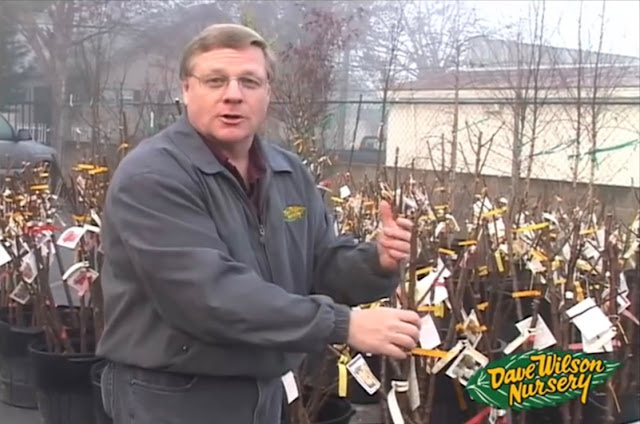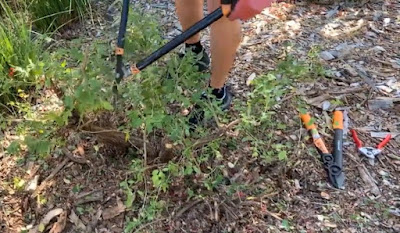
Let 2021 be the year of building on 2020's lessons

Ed Laivo gives advice on choosing a bare-root fruit tree in a Dave Wilson Nursery video, one of many videos linked on the Sacramento County master gardeners'
website
. (Screenshot)
Experience is a great teacher, and judging from social media posts, this year a lot of gardeners -- beginners and veterans -- received a lot of schooling on growing food and ornamentals.
We all were home more, with more time to nurture plants and see our gardens develop. Or not.
The "I'll throw some seeds in the ground" crowd learned that preparing the soil first would have helped those seeds germinate better and develop as strong seedlings. Good chance they're working on a compost pile and already may have done a soil test for missing nutrients.
The "why grow 5 tomato plants when I can grow 25" folks learned about keeping up with a large crop -- and the importance of strong support for all those plants. They're already planning stronger cages or better stakes. And maybe fewer tomatoes.
The "I'm not getting any squash" group learned that not all plants develop the same way. Squash, pumpkins and melons require both male and female flowers to pollinate -- and those flowers may not develop at the same time. These gardeners may have bought a paintbrush to transfer pollen themselves. And are likely planning more pollinator plants to entice more bees.
The "but it said full sun!" gardeners learned that this note on a plant or seed package doesn't mean Sacramento sun in July or August. They're already investing in shade cloth. Lots of shade cloth.
The large "what's eating my plants?" crowd learned that growing food can mean having to share with the local wildlife. They're researching greenhouses, plant cages and motion-operated sprinklers.
There were a lot more lessons, of course, depending on one's garden size, location, contents and personal experience.
Many fine sources of information are out there to help gardeners build on their experience/education. I recommend starting with the UCCE Sacramento County master gardeners' website , which is packed with information, charts and references for year-round gardening.

|
|
Master gardener Pat Schink demonstrates hard winter
pruning of a blooming salvia plant in one of the
Sacramento County master gardener videos. (Screenshot)
|
Sharpening hand pruners with Bill Black of the Sacramento master gardeners
Composting: Getting started with Susan Muckey of the Sacramento master gardeners
Shopping for bare-root fruit trees with Ed Laivo of Dave Wilson Nursery
Grafting fruit trees with Tom Spellman of Dave Wilson Nursery
Identifying and removing suckers on citrus trees with Kerry Beane of Four Winds Growers
Seed-starting with Ruth Ostroff of the Sacramento master gardeners
Pruning woody sages with Pat Schink of the Sacramento master gardeners. This video includes growing season and dormant season (winter) pruning of salvias.
With the outdoor world mostly resting, winter is the perfect time to read up on gardening topics, watch videos, and prepare for 2021 gardening.
Happy new year!
Comments
0 comments have been posted.Sacramento Digs Gardening to your inbox.
Sites We Like
Garden Checklist for week of April 21
This week there’s plenty to keep gardeners busy. With no rain in the immediate forecast, remember to irrigate any new transplants.
* Weed, weed, weed! Get them before they flower and go to seed.
* April is the last chance to plant citrus trees such as dwarf orange, lemon and kumquat. These trees also look good in landscaping and provide fresh fruit in winter.
* Smell orange blossoms? Feed citrus trees with a low dose of balanced fertilizer (such as 10-10-10) during bloom to help set fruit. Keep an eye out for ants.
* Apply slow-release fertilizer to the lawn.
* Thoroughly clean debris from the bottom of outdoor ponds or fountains.
* Spring brings a flush of rapid growth, and that means your garden is really hungry. Feed shrubs and trees with a slow-release fertilizer. Or mulch with a 1-inch layer of compost.
* Azaleas and camellias looking a little yellow? If leaves are turning yellow between the veins, give them a boost with chelated iron.
* Trim dead flowers but not leaves from spring-flowering bulbs such as daffodils and tulips. Those leaves gather energy to create next year's flowers. Also, give the bulbs a fertilizer boost after bloom.
* Pinch chrysanthemums back to 12 inches for fall flowers. Cut old stems to the ground.
* Mulch around plants to conserve moisture and control weeds.
* From seed, plant beans, beets, cantaloupes, carrots, corn, cucumbers, melons, radishes and squash.
* Plant onion sets.
* In the flower garden, plant seeds for asters, cosmos, celosia, marigolds, salvia, sunflowers and zinnias.
* Transplant petunias, zinnias, geraniums and other summer bloomers.
* Plant perennials and dahlia tubers for summer bloom.
* Mid to late April is about the last chance to plant summer bulbs, such as gladiolus and tuberous begonias.
* Transplant lettuce seedlings. Choose varieties that mature quickly such as loose leaf.